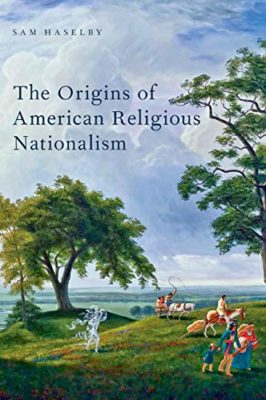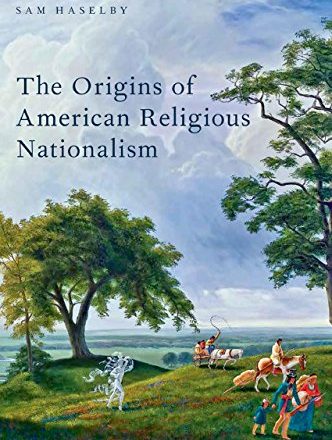A nation must think before it acts.
A review of Sam Haselby, The Origins of American Religious Nationalism. New York: Oxford University Press, 2015. x + 336 pp. $74.00 (cloth).

Why does it feel like Donald Trump changes everything? Possibly because when reading a book about nineteenth-century Protestantism, you cannot stop thinking about the leading Republican presidential candidate and the fault lines in American electoral politics that he has revealed. Consider, for instance, the parallels between Michael Lind’s assessment of the current political landscape in Politico, entitled “This is What the Future of American Politics Looks Like” and Sam Haselby’s rendering of nineteenth-century debates among Congregationalists, Methodists, and Baptists. First Lind:
Today’s Republican Party is predominantly a Midwestern, white, working-class party with its geographic epicenter in the South and interior West. Today’s Democratic Party is a coalition of relatively upscale whites with racial and ethnic minorities, concentrated in an archipelago of densely populated blue cities. . . .
The culture war and partisan realignment are over; the policy realignment and “border war” — a clash between nationalists, mostly on the right, and multicultural globalists, mostly on the left — has just begun. . . . For the nationalists, the most important dividing line is that between American citizens and everyone else—symbolized by Trump’s proposal for a Mexican border wall. . . . For multicultural globalists, national boundaries are increasingly obsolete and perhaps even immoral. According to the emerging progressive orthodoxy, the identities that count are subnational (race, gender, orientation) and supranational (citizenship of the world).
Now consider Haselby on a very similar dynamic that divided Northeastern Protestant descendants of the Puritans from frontier populist Protestants (read Baptists and Methodists):
The major tensions of westward expansion expressed themselves as a fight within Protestantism, a fight between frontier revivalism and national evangelism. It was essentially a contest for governance of the frontier, a contest between the migrants to the periphery, most small farmers, who were inventing popular American Protestantism, and Northeastern elite, mostly gentry and capitalists, who represented Reformed Protestantism and a new, nationalist missionary movement. (2-3)
For Protestant nationalists, Christian identity was bound up with American patriotism and the expansion of national ideals to the West and eventually around the globe. For frontier revivalists, national identity took a back seat to membership in the mystical body of Christ.
Even more poignant are the ties that Haselby draws implicitly between Andrew Jackson, the first truly populist U.S. president, and Donald Trump:
Increasing inequality, the rise of a cash economy, the creation of a dependent labor force, instruments of finance and incorporation, and other targets of the anti-missions [frontier revivalism] came with the rise of capitalism. . . . Like the artisans of Northern cities, . . frontier itinerants, spoke out on behalf of equality, the legitimacy of wealth derived from labor, and independent, local control. . . . To such proud and independent rural men, those for whom anti-mission Christians spoke, Andrew Jackson’s call to carry the banner of “common men” against aristocrats and bankers struck these deep chords. (293-294)
If that does not sound like a Protestant rendition of Trump’s economic nationalism and promises to protect “America First,” you likely have not been reading the news for explanations of Trump’s appeal. And if that does not motivate you to read Haselby’s book, not much else will.
Haselby’s central contribution with The Origins of American Religious Nationalism is in the field of U.S. religious history. Fifty years ago, scholars like Sidney E. Mead and Charles I. Foster showed the forceful ways in which Protestantism inserted itself into the new nation, an unlikely development given the secular grounds laid out by the likes of Thomas Jefferson and James Madison. In many respects, Haselby fleshes out those earlier studies and explains the odd alliance between frontier evangelicals and national secularists, as well as the institutional muscle that allowed East Coast Protestants to forge a cultural mainstream. Indeed, the cooperation, coordination, and consolidation that eastern evangelicals assembled would persist for at least another 150 years in the form of the so-called Protestant establishment. In that world of Americanism and Protestantism, the American way of life was synonymous with generic Protestant piety, such as the sort of prayer and Bible reading that public school teachers led down to the 1960s. What Haselby does so well in his book is to unpack the institutional aspects of the Protestant establishment: the financial backing of New York investors, the corporation laws that protected private religious institutions, and the consolidation of religious agencies that drew upon but had a separate existence from the churches. By being formally independent from the denominations, these agencies enabled the Protestant mainstream to form the tolerant and inclusive center in contrast to the sectarianism and parochialism of the frontier revivalists.
Haselby is equally adept as explaining the nationalism at work in these Protestant institutions. Protestant patriotism was so encompassing that it shaped the publication and distribution of the Bible itself. Through the American Bible Society (which is celebrating its 200th anniversary this year) despite the divisions among Protestants, Roman Catholics, and Jews (not to mention Muslims and non-Christians) the holy book generated, the Bible became a book that united the nation. As difficult a proposition as that may seem in hindsight, at the beginning of the nineteenth century when the nation was young and expanding to unsettled areas, having a Sunday school, a missionary from the East, and a library with a set of evangelical tracts printed in New York City made perfect sense if a town wanted to belong to the civilized world.
Although Haselby’s story is most relevant to nineteenth-century U.S. history, the legacy of his story – again with Trump in mind – is far from finished. The author suggests the ongoing power of older Protestant debates for contemporary politics and related quarrels about American identity when he highlights the sacral status that the founders and Declaration of Independence and Constitution gained through Protestant blessing. Haselby observes that a “simplified civil theology, a premium placed on religious toleration, the sacralization of the American Revolution, and the dominance of the jeremiad in American political discourse” are the chief ingredients of American religious nationalism. (20) Rather than forging a secular republic where courts and legislatures settled the interpretations of the founding, the religious contests between frontier and East Coast evangelicals shaped Americans understanding of 1776. In so doing, Protestants forged a civil religion that statesmen subsequently used to define American nationalism. Haselby quotes an Abraham Lincoln speech from 1838 to telling effect: fidelity to the revolution should “become the political religion of the nation; let the old and the young, the rich and the poor, the grave and the gay, of all sexes and tongues, and colors and conditions, sacrifice unceasingly upon its altars.” (19) This was a conception of the nation that Congregationalists and Presbyterians promoted in their welter of agencies, one that Baptists and Methodists refused.
This outlook on the sacral capacities of the United States is also responsible for inspiring American exceptionalism and its accompanying trope, “a shining city on a hill.” That New Testament phrase, first invoked by John Winthrop to describe the Puritan’s mission in New England, has been subsequently repackaged by every subsequent president to affirm the nation’s higher purpose, starting perhaps ironically with the Roman Catholic John F. Kennedy. It is still too early in the 2016 presidential contest to see how the theme of American greatness will play. What is clear, though, is that one of those candidates – Trump – is explicitly appealing to American exceptionalism (“make America great again”) without also invoking the language of a “city on a hill.” The Republican’s unwillingness so far to talk about the United States’ sacred calling gives additional leverage for noticing the parallels between antebellum America and today. Although Trump and Clinton both come from mainline Protestant backgrounds, the former echoes the populist side of American Protestantism while the latter has all the feel of the Protestant establishment.
For this reason, Haselby may hold the key to explaining what so far has escaped most scholars and pundits who are still scratching their heads about the 2016 presidential contest – namely, Trump’s appeal to evangelical voters for whom his flagrant flaunting of Christian morality should be repugnant. What if the world of American Protestantism is not divided, as historians insist, between the national outlets of evangelicals and mainliners? What if a body of believers exists that does not identify with either the National Association of Evangelicals or the National Council of Churches? What if many evangelicals, in Haselby’s words, “lack introspection, erudition, or style” and show no interest in “worldly affairs” or intellectual or policy debate? (130) And what if the national establishments (political or religious) seem distant to the experience of people on the margins whose faith encourages being peripheral? Of course, a faith for the poor and neglected has little chance of producing the resources necessary for a nation like the United States with its current domestic and international responsibilities. It is not 1819 anymore. But at a time when Protestantism seems to have run its course as a force in national politics, whether as the Protestant establishment or as the Religious Right, when some authors such as Robert P. Jones even talk of The End Of White Christian America, an understudied brand of Protestantism may still have life. Haselby unearths the early version of this Protestantism in U.S. history. He also gives reasons to think, especially now, that middle-America still matters.




